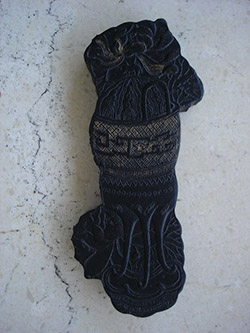A particular pleasure of well-designed inkcakes lies in the correspondence of the two sides. Ingeniously planned, a single shape must provide effective and varied compositions on the two faces of the inkcake. Some ensembles elaborate a common theme, such as in the sixty-piece set from which these two examples are taken. With imperial garden as their subject and replete with literary apparatus, this set was frequently reproduced in authorized (and pirate) copies for over a century.
Above: one side shows a bronze vessel with a lotus flower in full bloom, while its obverse depicts a lotus leaf emerging from a pond in which the name of the garden site is inscribed: studio with the aroma of antiquity' (古香齋). The rugged manner of the illustration recalls contemporary painting that was consciously archaic and informed by research on ancient bronzes.
Below: the ink takes the shape of a tall wine vessel within which is represented a winter scene with frozen water. The name of the site - 'Jade Pitcher, Ice' (玉壺冰) - combines the poetic metaphors ‘jade pitcher’ and ‘ice,’ each suggestive of nobility and purity. There is a delightful compositional conceit in the overlay of the vessel's spout in the landscape, where it dramatically parallels a mountain. | | 
 | 
 |